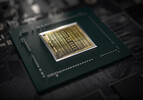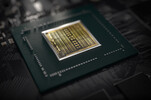NVIDIA GeForce GTX 1650 Mobile vs NVIDIA GeForce GTX 1660 Ti Max-Q
NVIDIA GeForce GTX 1650 Mobile
► remove from comparison
The Nvidia GeForce GTX 1650 for laptops is a mobile graphics card that is based on the Turing architecture (TU117 chip). Compared to the faster RTX 2000 GPUs (e.g. RTX 2060), the 1650 integrates no Raytracing or Tensor cores. The performance should be slightly faster than the old GeForce GTX 1050 Ti. Compared to the desktop version, the mobile GTX1650 can use all 1024 shaders of the TU117 chip, but there are also versions with 896 shaders.
Starting March 2020, the GTX 1650 Mobile is also available with fast 12 Gbits GDDR6 graphics memory (N18P-G61, 896 shaders) as a refresh.
The Turing generation did not only introduce raytracing for the RTX cards, but also optimized the architecture of the cores and caches. According to Nvidia the CUDA cores offer now a concurrent execution of floating point and integer operations for increased performance in compute-heavy workloads of modern games. Furthermore, the caches were reworked (new unified memory architecture with twice the cache compared to Pascal). This leads to 50% more instructions per clock and a 40% more power efficient usage compared to Pascal.
Compared to the bigger Turing chips (like the TU116 of the GTX 1660 Ti and the RTX lineup), the TU117 does not include the new NVENC encoder but an older one similar to the one used in Pascal and Volta.
The power consumption of the 1650 for laptops is specified at 50 Watt TGP (Total Graphics Power) by Nvidia and therefore 15 Watt higher than the efficient (and slower) Max-Q variant of the 1650. The TU117 chip is manufactured in 12nm FFN at TSMC.
NVIDIA GeForce GTX 1660 Ti Max-Q
► remove from comparison
The Nvidia GeForce GTX 1660 Ti with Max-Q Design is a mobile graphics card for laptops that is based on the Turing architecture (TU116 chip). It is designed for thin and light laptops and about 10-15% slower than a regular GTX 1660 Ti for laptops (depending on the cooling capabilities). According to the specifications, the Max-Q variant clocks 22% slower for the base speed and 16% for the boost speed.
Compared to the faster RTX 2000 GPUs (e.g. RTX 2060), the 1660Ti integrates no Raytracing or Tensor cores. The performance is similar to the old GTX 1070 (Max-Q) but at a reduced TGP of 60 Watt (versus 80 of the laptop version 115 Watt of the desktop version).
In April 2020 Nvidia refreshed the GTX 1660 Ti with the new codename N18E-G0-A1 with similar specs and pin compatible to the refreshed RTX chips (e.g., RTX 2070 Super Mobile).
The Turing generation did not only introduce raytracing for the RTX cards, but also optimized the architecture of the cores and caches. According to Nvidia the CUDA cores offer now a concurrent execution of floating point and integer operations for increased performance in compute-heavy workloads of modern games. Furthermore, the caches were reworked (new unified memory architecture with twice the cache compared to Pascal). This leads to 50% more instructions per clock and a 40% more power efficient usage compared to Pascal.
Nvidia specifies a power consumption of 60 Watt TGP (Total Graphics Power) and therefore 20 Watts lower than a normal (Max-P) 1660Ti for laptops. Therefore, the Max-Q variant is well suited for thin and light gaming laptops. The TU116 chip is manufactured in 12nm FFN at TSMC.
| NVIDIA GeForce GTX 1650 Mobile | NVIDIA GeForce GTX 1660 Ti Max-Q | |||||||||||||||||||||||||||||||||||||||||||||||||||||||||||||||||||
| GeForce GTX 1600 Series |
|
| ||||||||||||||||||||||||||||||||||||||||||||||||||||||||||||||||||
| Codename | N18P-G0, N18P-G61 | N18E-G0 | ||||||||||||||||||||||||||||||||||||||||||||||||||||||||||||||||||
| Architecture | Turing | Turing | ||||||||||||||||||||||||||||||||||||||||||||||||||||||||||||||||||
| Pipelines | 1024 - unified | 1536 - unified | ||||||||||||||||||||||||||||||||||||||||||||||||||||||||||||||||||
| TMUs | 56 | |||||||||||||||||||||||||||||||||||||||||||||||||||||||||||||||||||
| ROPs | 32 | |||||||||||||||||||||||||||||||||||||||||||||||||||||||||||||||||||
| Core Speed | 1380 - 1560 (Boost) MHz | 1140 - 1335 (Boost) MHz | ||||||||||||||||||||||||||||||||||||||||||||||||||||||||||||||||||
| Memory Speed | 12000 effective = 1500 MHz | 12000 MHz | ||||||||||||||||||||||||||||||||||||||||||||||||||||||||||||||||||
| Memory Bus Width | 128 Bit | 192 Bit | ||||||||||||||||||||||||||||||||||||||||||||||||||||||||||||||||||
| Memory Type | GDDR5, GDDR6 | GDDR6 | ||||||||||||||||||||||||||||||||||||||||||||||||||||||||||||||||||
| Max. Amount of Memory | 4 GB | 6 GB | ||||||||||||||||||||||||||||||||||||||||||||||||||||||||||||||||||
| Shared Memory | no | no | ||||||||||||||||||||||||||||||||||||||||||||||||||||||||||||||||||
| Memory Bandwidth | 192 GB/s | |||||||||||||||||||||||||||||||||||||||||||||||||||||||||||||||||||
| API | DirectX 12_1, OpenGL 4.6 | DirectX 12_1, OpenGL 4.6 | ||||||||||||||||||||||||||||||||||||||||||||||||||||||||||||||||||
| Power Consumption | 50 Watt | 60 Watt | ||||||||||||||||||||||||||||||||||||||||||||||||||||||||||||||||||
| technology | 12 nm | 12 nm | ||||||||||||||||||||||||||||||||||||||||||||||||||||||||||||||||||
| PCIe | 4.0 | |||||||||||||||||||||||||||||||||||||||||||||||||||||||||||||||||||
| Notebook Size | medium sized | medium sized | ||||||||||||||||||||||||||||||||||||||||||||||||||||||||||||||||||
| Date of Announcement | 23.04.2019 | 23.04.2019 | ||||||||||||||||||||||||||||||||||||||||||||||||||||||||||||||||||
| Link to Manufacturer Page | www.nvidia.com | www.nvidia.com |
Benchmarks
3DM Vant. Perf. total + NVIDIA GeForce GTX 1650 Mobile
Cinebench R15 OpenGL 64 Bit + NVIDIA GeForce GTX 1650 Mobile
GFXBench T-Rex HD Offscreen C24Z16 + NVIDIA GeForce GTX 1650 Mobile
Average Benchmarks NVIDIA GeForce GTX 1650 Mobile → 100% n=29
Average Benchmarks NVIDIA GeForce GTX 1660 Ti Max-Q → 117% n=29
* Smaller numbers mean a higher performance
1 This benchmark is not used for the average calculation
Game Benchmarks
The following benchmarks stem from our benchmarks of review laptops. The performance depends on the used graphics memory, clock rate, processor, system settings, drivers, and operating systems. So the results don't have to be representative for all laptops with this GPU. For detailed information on the benchmark results, click on the fps number.

Enshrouded
2024
Palworld
2024
Ready or Not
2023
The Finals
2023
EA Sports WRC
2023
Alan Wake 2
2023
Lords of the Fallen
2023
Total War Pharaoh
2023
EA Sports FC 24
2023
Counter-Strike 2
2023
Baldur's Gate 3
2023
Lies of P
2023
The Crew Motorfest
2023
Starfield
2023
Armored Core 6
2023
Immortals of Aveum
2023
Atlas Fallen
2023
F1 23
2023
Diablo 4
2023
Dead Island 2
2023
The Last of Us
2023
Company of Heroes 3
2023
Sons of the Forest
2023
Atomic Heart
2023
Returnal
2023
Hogwarts Legacy
2023
Dead Space Remake
2023
The Witcher 3 v4
2023
High On Life
2023
The Quarry
2022
F1 22
2022
Vampire Bloodhunt
2022
Ghostwire Tokyo
2022
Cyberpunk 2077 1.6
2022
Elex 2
2022
GRID Legends
2022
Elden Ring
2022
Dying Light 2
2022
God of War
2022
Halo Infinite
2021
Farming Simulator 22
2021
Battlefield 2042
2021
Forza Horizon 5
2021
Riders Republic
2021
Back 4 Blood
2021
Far Cry 6
2021
Alan Wake Remastered
2021
FIFA 22
2021
New World
2021
Deathloop
2021
F1 2021
2021
Days Gone
2021
Outriders
2021
Hitman 3
2021
Cyberpunk 2077 1.0
2020
Yakuza Like a Dragon
2020
Dirt 5
2020
Watch Dogs Legion
2020
FIFA 21
2020
Star Wars Squadrons
2020
Serious Sam 4
2020
Crysis Remastered
2020
Horizon Zero Dawn
2020
Death Stranding
2020
F1 2020
2020
Valorant
2020
Gears Tactics
2020
Doom Eternal
2020
Hunt Showdown
2020
Escape from Tarkov
2020
Need for Speed Heat
2019
GRID 2019
2019
FIFA 20
2019
Borderlands 3
2019
Control
2019
F1 2019
2019
Rage 2
2019
Anno 1800
2019
The Division 2
2019
Dirt Rally 2.0
2019
Anthem
2019
Far Cry New Dawn
2019
Metro Exodus
2019
Apex Legends
2019
Just Cause 4
2018
Darksiders III
2018
Battlefield V
2018
Farming Simulator 19
2018
Hitman 2
2018
Forza Horizon 4
2018
FIFA 19
2018
F1 2018
2018
Monster Hunter World
2018
The Crew 2
2018
Far Cry 5
2018
X-Plane 11.11
2018
Fortnite
2018
Destiny 2
2017
ELEX
2017
Team Fortress 2
2017
Rocket League
2017
Prey
2017
For Honor
2017
Resident Evil 7
2017
Dishonored 2
2016
Battlefield 1
2016
Civilization 6
2016
Overwatch
2016
Doom
2016
Rainbow Six Siege
2015
World of Warships
2015
Metal Gear Solid V
2015
Dota 2 Reborn
2015
The Witcher 3
2015
GTA V
2015
BioShock Infinite
2013
Tomb Raider
2013
Counter-Strike: GO
2012
Diablo III
2012
StarCraft 2
2010Average Gaming NVIDIA GeForce GTX 1650 Mobile → 100%
Average Gaming 30-70 fps → 100%
Average Gaming NVIDIA GeForce GTX 1660 Ti Max-Q → 125%
Average Gaming 30-70 fps → 129%
| NVIDIA GeForce GTX 1650 Mobile | NVIDIA GeForce GTX 1660 Ti Max-Q | |||||||||||||
|---|---|---|---|---|---|---|---|---|---|---|---|---|---|---|
| low | med. | high | ultra | QHD | 4K | low | med. | high | ultra | QHD | 4K | |||
| Enshrouded | 25.5 | 23 | 15.1 | 12.1 | ||||||||||
| Palworld | 50.6 | 43.8 | 33.6 | 31 | ||||||||||
| Prince of Persia The Lost Crown | 291 | 211 | 196.6 | |||||||||||
| Ready or Not | 83.5 | 71.3 | 63.5 | 41.3 | ||||||||||
| The Finals | 100.2 | 70.4 | 60.4 | 43.3 | ||||||||||
| Avatar Frontiers of Pandora | 22 | 19 | 13 | |||||||||||
| Call of Duty Modern Warfare 3 2023 | 56 | 50 | 37 | 27 | ||||||||||
| EA Sports WRC | 50.5 | 40.8 | 26.4 | 17.8 | ||||||||||
| Alan Wake 2 | 23.6 | 21.1 | 18.5 | |||||||||||
| Lords of the Fallen | 31 | 25.4 | 18.3 | 12 | ||||||||||
| Total War Pharaoh | 144.4 | 93.1 | 53.3 | 41.6 | ||||||||||
| Assassin's Creed Mirage | 49 | 46 | 28 | 18 | ||||||||||
| EA Sports FC 24 | 58 | |||||||||||||
| Counter-Strike 2 | 130.6 | 113.2 | 79.5 | 55.4 | ||||||||||
| Cyberpunk 2077 2.2 Phantom Liberty | 41 | 32.2 | 27 | 22.5 | ||||||||||
| Baldur's Gate 3 | 49 | 37.6 | 33.2 | 32.1 | ||||||||||
| Lies of P | 62.8 | 55.2 | 46.6 | 41.5 | ||||||||||
| The Crew Motorfest | 46 | 41 | 33 | 28 | ||||||||||
| Starfield | 28.3 | 23 | 18.2 | 15.9 | ||||||||||
| Armored Core 6 | 64.5 | 54.4 | 41.7 | 21.3 | ||||||||||
| Immortals of Aveum | 27.4 | 25.6 | 22.4 | |||||||||||
| Atlas Fallen | 53.3 | 49.7 | 47.2 | 28.8 | ||||||||||
| Ratchet & Clank Rift Apart | 27.6 | 20.8 | 15.1 | 12.9 | ||||||||||
| F1 23 | 109.8 | 98.4 | 65.7 | 38.4 | ||||||||||
| Diablo 4 | 91.3 | 78.5 | 72.1 | 58.5 | ||||||||||
| Star Wars Jedi Survivor | 28.8 | 23.6 | 22.4 | 21.1 | ||||||||||
| Dead Island 2 | 92.4 | 75.3 | 49.7 | 38.8 | ||||||||||
| The Last of Us | 34.5 | 25.9 | 19.3 | |||||||||||
| Resident Evil 4 Remake | 46.1 | 32.6 | 28.6 | 13.7 | ||||||||||
| Company of Heroes 3 | 65.4 | 57.4 | 44.6 | 45.3 | ||||||||||
| Sons of the Forest | 53 | 32.3 | 31.5 | 30.1 | ||||||||||
| Atomic Heart | 68.7 | 50.5 | 30.3 | 23 | ||||||||||
| Returnal | 39 | 37 | 33 | 23 | ||||||||||
| Hogwarts Legacy | 51.2 | 37.5 | 28.5 | 18.4 | ||||||||||
| Dead Space Remake | 31.3 | 25.6 | 21.8 | 15 | ||||||||||
| The Witcher 3 v4 | 79.4 | 58.7 | 21 | |||||||||||
| High On Life | 111.2 | 60.7 | 48.7 | 39.9 | ||||||||||
| The Callisto Protocol | 52.7 | 53.1 | 53 | 53.2 | ||||||||||
| Need for Speed Unbound | 59.5 | 53 | 33 | 22.2 | ||||||||||
| Spider-Man Miles Morales | 57.4 | 40.6 | 34.1 | 29.4 | ||||||||||
| Uncharted Legacy of Thieves Collection | 38.9 | 29.3 | 17.2 | 16.4 | ||||||||||
| A Plague Tale Requiem | 38.5 | 30.6 | 26.1 | 22.1 | ||||||||||
| The Quarry | 57 | 41.6 | 34.3 | 25.3 | ||||||||||
| F1 22 | 116 | 105.2 | 74.2 | 53.2 | ||||||||||
| Vampire Bloodhunt | 120.7 | 91.5 | 77.3 | 70 | ||||||||||
| Ghostwire Tokyo | 65.8 | 53.6 | 53 | 52.2 | ||||||||||
| Cyberpunk 2077 1.6 | 51.8 | 41.3 | 32 | 30 | 14.9 | 5.4 | ||||||||
| Elex 2 | 50.4 | 43.4 | 37.1 | 32.8 | ||||||||||
| GRID Legends | 131 | 92.2 | 76.4 | 53.2 | ||||||||||
| Elden Ring | 58.3 | 55.6 | 50.5 | 43.1 | 31.4 | 17.3 | ||||||||
| Dying Light 2 | 37.6 | 28.7 | 23.8 | |||||||||||
| Rainbow Six Extraction | 79 | 72 | 69 | 53 | ||||||||||
| God of War | 47 | 38 | 32 | 20 | ||||||||||
| Halo Infinite | 101 | 56.1 | 40.6 | 36 | ||||||||||
| Farming Simulator 22 | 163 | 104 | 77 | 61.9 | 45 | 26.1 | ||||||||
| Battlefield 2042 | 102 | 53.8 | 43.9 | 9.94 | 4.18 | |||||||||
| Forza Horizon 5 | 68 | 60 | 22 | 18 | 12 | |||||||||
| Call of Duty Vanguard | 59.8 | 33.9 | 33.4 | 23.3 | 12.6 | |||||||||
| Riders Republic | 60 | 46 | 39 | 25 | 8 | |||||||||
| Guardians of the Galaxy | 48 | 46 | 44 | 31 | 6 | |||||||||
| Back 4 Blood | 96 | 82.3 | 75 | 49.1 | 23.3 | |||||||||
| Far Cry 6 | 68.5 | 58 | 50 | 44 | 30 | |||||||||
| Alan Wake Remastered | 73.2 | 63.4 | 42 | |||||||||||
| FIFA 22 | 166 | 161 | 143 | 116 | 75.8 | |||||||||
| New World | 44.4 | 41.9 | 30.6 | 18.1 | 10.4 | |||||||||
| Deathloop | 51.2 | 37.3 | 34.3 | 22.1 | 8.11 | |||||||||
| F1 2021 | 148 | 102 | 86 | 58 | ||||||||||
| Monster Hunter Stories 2 | 118 | 107 | 82.4 | 50.4 | ||||||||||
| Days Gone | 63.8 | 55.5 | 40.1 | 28.3 | 15.6 | |||||||||
| Mass Effect Legendary Edition | 106 | 90.3 | 67.5 | 33.7 | ||||||||||
| Resident Evil Village | 71.4 | 64.1 | 52 | 26.3 | 13.8 | |||||||||
| Outriders | 66.8 | 53.6 | 43.1 | 31.6 | 23.4 | |||||||||
| Hitman 3 | 153.4 | 69 | 60 | 54 | 36.5 | 19.3 | ||||||||
| Cyberpunk 2077 1.0 | 46 | 28 | 24 | 20 | 14.1 | 5.8 | ||||||||
| Immortals Fenyx Rising | 73 | 51 | 35 | 29 | 23 | 14 | ||||||||
| Yakuza Like a Dragon | 57.1 | 47 | 42 | 37 | 25.8 | 12.8 | ||||||||
| Call of Duty Black Ops Cold War | 85 | 46 | 32 | 25 | 20.8 | 9.64 | ||||||||
| Assassin´s Creed Valhalla | 66 | 42 | 24 | 8 | ||||||||||
| Dirt 5 | 93 | 46 | 36 | 23 | 13.8 | |||||||||
| Watch Dogs Legion | 75 | 50 | 42 | 16 | 12.3 | |||||||||
| FIFA 21 | 182 | 146 | 141 | 131 | 115 | 77.2 | ||||||||
| Star Wars Squadrons | 144 | 108 | 99 | 90 | ||||||||||
| Mafia Definitive Edition | 85 | 47 | 44 | 29 | 14.6 | |||||||||
| Serious Sam 4 | 107 | 52 | 43 | 26 | 21.7 | |||||||||
| Crysis Remastered | 110 | 60 | 33 | 25 | 18.4 | 10.1 | ||||||||
| Flight Simulator 2020 | 55 | 38 | 27 | 18 | 13.2 | 5.03 | 55.1 | 49.4 | 37.1 | 25.3 | ||||
| Horizon Zero Dawn | 87 | 53 | 44 | 35 | 24 | 15 | 119 | 78 | 65 | 51 | ||||
| Death Stranding | 106 | 64 | 59 | 57 | 36 | 17.8 | 136.1 | 87.7 | 81.3 | 78.4 | ||||
| F1 2020 | 182 | 102 | 81 | 57 | 44 | 23 | 219 | 130 | 112 | 79 | ||||
| Valorant | 170 | 164 | 148 | 159 | 90 | |||||||||
| Gears Tactics | 211 | 96 | 65 | 45 | 29.9 | 14.6 | 214.7 | 130.2 | 79.9 | 56.1 | ||||
| Doom Eternal | 140 | 82 | 66 | 168.9 | 101.7 | 95.4 | 93.4 | |||||||
| Hunt Showdown | 148 | 57 | 47 | 27.1 | 12.5 | 176.8 | 81.2 | 63.3 | ||||||
| Escape from Tarkov | 121 | 80 | 63 | 54 | 32.9 | 15.7 | 121.2 | 98.3 | 90.5 | 87.7 | ||||
| Red Dead Redemption 2 | 79 | 48 | 33 | 21 | 115.1 | 71.7 | 47.2 | 29.4 | ||||||
| Star Wars Jedi Fallen Order | 73 | 62 | 53 | 33.3 | 16.9 | 91.5 | 78.1 | 72.4 | ||||||
| Need for Speed Heat | 87 | 62 | 55 | 48 | 32.2 | 17 | 95.8 | 83 | 73.9 | 66.9 | ||||
| Call of Duty Modern Warfare 2019 | 104 | 64 | 56 | 47 | 37.6 | 6.7 | 135.2 | 88 | 72.6 | 62.6 | ||||
| GRID 2019 | 129 | 74 | 59 | 40 | 26 | 14 | 112.9 | 86.5 | 72 | 58.7 | ||||
| Ghost Recon Breakpoint | 90 | 51 | 47 | 34 | 99 | 70 | 66 | 50 | ||||||
| FIFA 20 | 203 | 167 | 161 | 148 | 128 | 84.4 | 147.9 | 145.4 | 141 | 139.3 | ||||
| Borderlands 3 | 104 | 59 | 39 | 31 | 18.3 | 6.3 | 102 | 77 | 54 | 42 | ||||
| Control | 136 | 45 | 33 | 20.6 | 9.8 | 158.3 | 63.7 | 47.1 | ||||||
| F1 2019 | 154 | 100 | 81 | 61 | 45 | 27 | 169 | 130 | 112 | 74 | ||||
| Total War: Three Kingdoms | 152 | 64 | 39 | 26 | 177 | 85 | 56 | 41 | ||||||
| Rage 2 | 119 | 69 | 56 | 51 | 151 | 74 | 62 | 62 | ||||||
| Anno 1800 | 60 | 57 | 40 | 20 | 13.8 | 8.3 | 74 | 71 | 55 | 30 | ||||
| The Division 2 | 98 | 64 | 51 | 38 | 29 | 14 | 126 | 84 | 68 | 50 | ||||
| Dirt Rally 2.0 | 174 | 90 | 72 | 43 | 31.9 | 188 | 121 | 96 | 58 | |||||
| Anthem | 53 | 50 | 45 | 40 | 31.5 | 16.5 | 53.6 | 48.9 | 48.8 | 46.4 | ||||
| Far Cry New Dawn | 72 | 56 | 55 | 50 | 39 | 19 | 97 | 81 | 78 | 71 | ||||
| Metro Exodus | 84 | 43 | 32 | 26 | 19.6 | 11.8 | 103 | 60 | 47 | 37 | ||||
| Apex Legends | 144 | 86 | 69 | 68 | 47.8 | 26.4 | 144 | 120 | 95 | 94 | ||||
| Just Cause 4 | 78.5 | 55.5 | 51.8 | 34.3 | 17.4 | |||||||||
| Darksiders III | 96.8 | 74 | 61 | 55 | 35.2 | 11.1 | 135.6 | 85.8 | 77.4 | 72.8 | ||||
| Battlefield V | 80 | 66 | 60 | 56 | 47.3 | 24.6 | 121 | 87 | 79 | 73 | 37.9 | |||
| Farming Simulator 19 | 157 | 98.4 | 74.3 | 47.6 | ||||||||||
| Hitman 2 | 66.4 | 60.1 | 55.9 | 36.9 | 17.4 | |||||||||
| Call of Duty Black Ops 4 | 121.6 | 81 | 72 | 68 | 43.1 | 20.5 | 115.2 | 87.9 | 84.6 | 83.1 | ||||
| Assassin´s Creed Odyssey | 59 | 54 | 46 | 31 | 22 | 12 | 67 | 57 | 50 | 40 | ||||
| Forza Horizon 4 | 97 | 82 | 80 | 62 | ||||||||||
| FIFA 19 | 104 | 166 | 148 | 136 | 99 | 69.4 | ||||||||
| Shadow of the Tomb Raider | 94 | 57 | 49 | 43 | 30 | 15 | 96 | 70 | 64 | 57 | ||||
| Strange Brigade | 183 | 82 | 66 | 56 | ||||||||||
| F1 2018 | 117 | 91 | 58 | 45 | 25 | |||||||||
| Monster Hunter World | 59.5 | 51.3 | 40.9 | 24.7 | 11.7 | 66.9 | 59.3 | 59.5 | 50.8 | |||||
| The Crew 2 | 60 | 60 | 53.7 | 35.2 | 17.4 | |||||||||
| Far Cry 5 | 81 | 57 | 53 | 51 | 35 | 18 | 86 | 69 | 66 | 62 | 30 | |||
| World of Tanks enCore | 329 | 163 | 73 | 376.8 | 215.9 | 117.3 | ||||||||
| X-Plane 11.11 | 84 | 72 | 62 | 76.1 | 81 | 71 | 62 | |||||||
| Kingdom Come: Deliverance | 66.2 | 53 | 39.7 | 24.6 | 11.6 | 125.6 | 91.7 | 77.3 | 53.7 | |||||
| Final Fantasy XV Benchmark | 73 | 50 | 35 | 25 | 14 | 105 | 68 | 50 | ||||||
| Fortnite | 72.3 | 44.1 | 138 | 92.2 | 89.5 | 78.6 | ||||||||
| Star Wars Battlefront 2 | 75.7 | 66.2 | 56.8 | 35.6 | 10.5 | |||||||||
| Need for Speed Payback | 92.1 | 77.6 | 74 | 47.5 | 23.4 | |||||||||
| Destiny 2 | 85.4 | 75.1 | 72.7 | 62.4 | ||||||||||
| ELEX | 75.6 | 58.8 | 45.2 | 28.8 | 14.6 | |||||||||
| Middle-earth: Shadow of War | 76 | 57 | 43 | 18 | 91 | 82 | 72 | 61 | ||||||
| Playerunknown's Battlegrounds (PUBG) | 70.7 | |||||||||||||
| Team Fortress 2 | 92 | 85 | 77 | 75 | ||||||||||
| Rocket League | 241 | 189 | 135 | 47 | 227 | 186 | 158 | |||||||
| Prey | 127 | 103 | 84.7 | 29 | ||||||||||
| Ghost Recon Wildlands | 62.8 | 57.3 | 31.2 | 17.9 | 130.4 | 78.1 | 72.4 | 41.5 | ||||||
| For Honor | 81.5 | 77.4 | 60.1 | 23.6 | ||||||||||
| Resident Evil 7 | 176 | 94.8 | 78.8 | 25.5 | ||||||||||
| Dishonored 2 | 67.5 | 53.8 | 26 | |||||||||||
| Battlefield 1 | 74.5 | 71.1 | ||||||||||||
| Civilization 6 | 111.4 | 83 | 59.4 | 53.7 | ||||||||||
| Deus Ex Mankind Divided | 53.3 | 27.5 | 17 | |||||||||||
| Mirror's Edge Catalyst | 68.6 | 61.1 | 21.5 | |||||||||||
| Overwatch | 165.2 | 140 | 84 | 47.1 | 193.7 | 140.7 | 116 | |||||||
| Doom | 109 | 101 | 34.5 | |||||||||||
| Ashes of the Singularity | 46.4 | 40 | 36 | 42.4 | 40.7 | |||||||||
| Rise of the Tomb Raider | 136 | 102.8 | 61 | 51 | 20.2 | 93.7 | 72.7 | 64.5 | ||||||
| Rainbow Six Siege | 154 | 130 | 50.3 | 232.8 | 200.1 | 163.6 | 148.8 | |||||||
| World of Warships | 124.7 | 105.9 | 84.6 | 84.2 | ||||||||||
| Dota 2 Reborn | 121 | 109 | 99 | 93 | 48 | 108 | 101 | 94 | 88 | |||||
| Batman: Arkham Knight | 103 | 89 | 72 | 47 | 89 | 69 | 51 | |||||||
| The Witcher 3 | 167 | 109 | 62 | 36 | 21 | 212 | 154 | 88 | 50 | 30.9 | ||||
| GTA V | 130 | 122 | 80 | 43 | 161.3 | 151.5 | 114.6 | 59.6 | ||||||
| Middle-earth: Shadow of Mordor | 136 | 123.1 | 84.2 | 69.3 | ||||||||||
| BioShock Infinite | 252 | 212 | 192 | 86 | 259 | 250 | 229 | 117 | ||||||
| Counter-Strike: GO | 200.8 | 182.6 | 162.1 | 130 | ||||||||||
| Diablo III | 139.5 | 123.7 | 122.9 | 103.3 | ||||||||||
| StarCraft 2 | 267.9 | 125 | 123.7 | 102.2 | ||||||||||
| NVIDIA GeForce GTX 1650 Mobile | NVIDIA GeForce GTX 1660 Ti Max-Q | |||||||||||||
| low | med. | high | ultra | QHD | 4K | low | med. | high | ultra | QHD | 4K | < 30 fps < 60 fps < 120 fps ≥ 120 fps | 7 32 50 37 | 12 59 65 17 | 22 71 54 13 | 40 73 29 7 | 33 32 5 2 | 66 7 6 | < 30 fps < 60 fps < 120 fps ≥ 120 fps | 2 20 27 | 5 31 12 | 12 33 5 | 2 19 22 2 | | 3 |
For more games that might be playable and a list of all games and graphics cards visit our Gaming List



























































